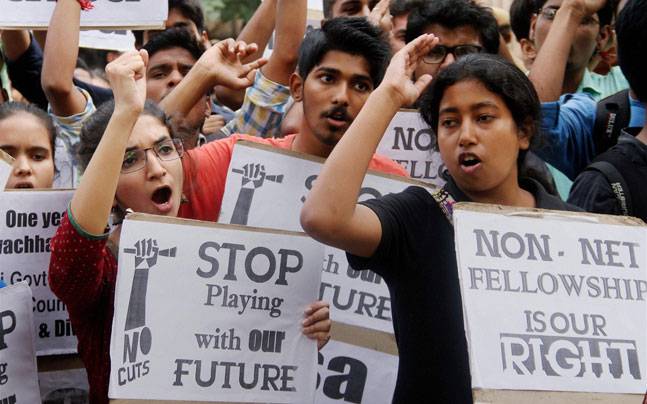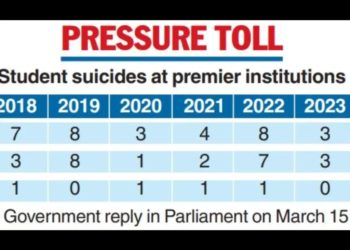The Report of the Committee on National Education Policy (2016) takes cognizance of the sorry state of our education. After a long while, there appears to be a tentative awareness of the need to liberate higher education from the Ixion wheel of endless, identical repetition.
Prime Minister Narendra Modi has announced a sum of Rs. 10000 crores for twenty meritorious universities to enable them to be world-class. But why are our universities the way they are? Is the Prime Minister’s plan to distribute bonanzas to a handful of universities the way forward? Or will it aggravate the present malady?
The answer to this question touches the idea of ‘university’. Etymologically, university connotes the ‘whole’ and the ‘universal’ (Latin: universus). In pre-Enlightenment periods, university symbolized a quest for wholeness of knowledge. With the dawn of democracy, it should have embraced demographic wholeness as well and spread to the masses. That did not happen.
It became, instead, “a secret alliance”, in the words of August Strindberg (1849-1912), “of the upper against the lower classes”. This class bias, according to him, frustrated the intellectual scope of universities with the indulgence and frivolity that go with socio-economic privilege. To quote Strindberg again, “What was the usual subject of the young men’s conversation? Their studies? Never! Once in a way, perhaps, they would talk of certificates. No, their conversation was of things obscene; of appointments with women, of billiards . . .”
One would have expected that with the onset of the Enlightenment in the 18th and 19th centuries, universities would become centres for broad-basing interest in the ‘best that is thought and known in the world’. That did not happen. Instead, European Enlightenment infected the socio-economic elite with the anxiety that its spread could precipitate revolution and imperil ‘national interests’.
The tacit compromise reached on this issue was that Enlightenment was appropriate, not for the common man, but only for the ruling elite. Enlightenment thus infused class hegemony into western liberalism. It is necessary to remember this background in thinking our higher education through, for the reason that the model of higher education we follow is a residue of the European enlightenment project.
Besides this class-bias, the model of higher education imported into India was burdened by a tradition of State control. It ensured that the practice of higher education coincided, for all practical purposes, with the interests of the State.
This explains why all humanistic and idealistic goals proposed for education -social transformation, personal empowerment, character building, social justice, nation-building etc. – were progressively side-lined. No attempt to reform higher education has addressed these issues upfront, and no government since Independence shown any will to make the education project harmonize with the culture and needs of democracy.
Seen in this light, PM Modi’s spontaneous fit of selective generosity towards universities -presumably to nudge them into the global elite club- turns out to be of the very same mindset that has kept higher education shackled by the exclusivist interests of ruling dispensations for centuries. This is not to take a cynical view of an otherwise laudable initiative, but to invoke a historical perspective on what would almost certainly be the outcome. Steps like what the PM has announced will further reinforce the elite orientation that keeps higher education in endless intellectual twilight.
It is a pity that even at this eleventh hour we are indifferent to evolving a contextually proactive idea of higher education that can help the genius of India to bloom. This is not an accident, but an inevitable outcome of the apprehensions that the ruling class entertains in this regard.
Envisaging the genius and the promise of India as exceeding the circumference of socio-economic elitism is eminently avoidable to such a perspective. Any compromise on this class-caste bias vis-à-vis higher education is customarily viewed with incipient anxiety.
As of now there are 789 universities listed on the UGC website. Out of them twenty -already the most privileged- would be selected for disproportionate fattening. This, at a time when the allocation for education is, in real terms, shrinking. These privileged universities will cater almost exclusively to the socio-economic elite; for, merit as understood in the context of education to this day is mostly determined by the accidents of birth.
It is intriguing that our universities are not audited for minimum standards of excellence and time-bound corrective measures fixed for their standardization. (NAAC is, in concept and competence, inadequate and inappropriate for this purpose.) If standardizing, tax via GST, is good for the country, why is standardizing quality in education not good for the country? Everyone who thinks rationally and democratically on the development of the country will come to the conclusion that education is not any less important than tax collection. It is, if anything, more vital to the ‘liberation’ of India than GST. If this is not being acknowledged as such, it is because it is perceived to be inimical to the interests that drive the juggernaut of the State.
If India is serious about attaining global standards in education, the following aspects need urgent attention-
1. We have to develop a tradition of pursuing excellence in education. This is not a matter of funding alone. That is why I quoted Strindberg. The taste that prevails in the beneficiaries of education and in the learning environment must change. On the part of teachers, education must cease to be merely a means for earning easy livelihood and become a serious commitment to ‘calling up and calling out’ (the Latin meaning of education) the best potential that this country holds in its 1.3 billion people.
2. The State, on its part, must see education as a sphere of righteousness; ‘righteousness,’ understood as the availability of conditions favourable for the free and full expression of the best potential in every Indian. We must not any longer use higher education as an instrument of exclusion, but reconfigure it as a means for empowerment enlivened by equality of opportunity for all.
3. A protocol for rigorous ‘quality control’ must be evolved and implemented without let or hindrance. Higher education in this country has become a haven of mediocrity, sheltered from accountability. This must change. Education as a whole must become a zone of zero-tolerance for corruption, with its attendant evils of mediocrity and truancy at work. Institutions that cannot adapt to the stipulated architecture of quality must fall by the wayside.
3. The State must assume increasing responsibility for providing -not merely funding- higher education of excellence. Nearly cent percent of education is State-run in Japan. Our newly cultivated proximity to that country should inspire us to emulate its example. The present trend of the State withdrawing from education must be reversed. The HRD ministry must be brought under the Prime Minister.
4. Citizens, on their part, must use their franchise to force the State to improve quality and quantity of education. Parties and ideologies inimical to the educational invigoration of India must be rejected.
5. Above all, social justice must be integrated into higher education. The idea that commitment to social justice will cripple pursuit of excellence in higher education is an elitist myth. My experience has been that it fortifies the pursuit of excellence. Diversity, not socio-economic homogenization, is germane to excellence in any field.
In 2007, when I took over St. Stephen’s, it did not figure among the top five colleges in the country in the India Today survey. By 2013, it became the number one college in science and humanities. The secret of this academic resurgence was the enlargement of its social footprint in respect of students.
The entrenched prejudice against social justice is an un-enlightened relic of European Enlightenment. It has stalked our faltering steps in higher education for too long. It’s high time that we broke these fetters and unleashed the awesome potential of India.





